While it certainly isn’t fair to reduce McLaren’s ‘1’ series cars to numbers, they do tend to arrive with some eye-openers. Lest we forget, the F1 had 627hp from a 6.1-litre V12, weighed 1,260kg at the kerb and famously hit 240mph. In 1992. Two decades later, the P1 could summon up 916hp from a hybridised 3.8-litre twin-turbocharged V8, and get to 124mph in 6.8 seconds before hitting a limiter at 217mph. It weighed 1,395kg dry. Neither was built specifically for the track, but they were absolutely meant to be the tip of the technological spear so far as performance was concerned. The ultimate road cars, in other words.
The W1 might very well get its ‘W’ as a homage to ‘McLaren’s World Championship mindset’, but it has been built along similar lines. It wants to be thought ahead of its time and at the bleeding edge of what’s possible with numberplates and space for two people. And it arrives with its own set of bewildering digits: among them a maximum output of 1,275hp and 988lb ft of torque from an all-new electrified 4.0-litre V8, and a 0-186mph time which is nearly four seconds quicker than its predecessor. In fact, McLaren says it’s quicker even than a Speedtail to the same benchmark. While reportedly being three seconds a lap faster than a Senna around Nardo’s reference track. Which, succinctly, makes it the quickest accelerating and fastest lapping road-legal McLaren ever.


We expected nothing less, of course – the very nature of the ‘1’ legacy meant the manufacturer was duty-bound to outdo itself, and its perfectionist tendencies abound in the newcomer. But perhaps we expected more from the car’s appearance, which has everything from a Bugatti Tourbillion to a GMA T.50 to worry about when it comes to modern hypercar bragging rights. Given the (slightly unfair) flak McLaren gets for supposedly remaking the same car, it would’ve been forgiven for shamelessly breaking the mould here. Instead, it has stuck to its well-worn wind tunnel rationale: the W1 features the most advanced active aero package it has ever applied to a road car. The look is partly a slave to that reality.
In fairness to it – and having seen it in the flesh – the car isn’t actually short of head-turning aura; it just needs a little unpacking for you to truly appreciate it. Which is hardly surprising when a) there is so much going on underneath and b) it is built to showily change shape at the touch of a button. The new Aerocell carbon fibre monocoque, described as the ‘centrepiece’ of the car’s aerodynamic effort, is unique to the W1, and McLaren’s lightest yet. A raised floor means it has no front subframe – the inboard front suspension is mounted directly to it – as are the fixed lightweight seats, which reduces the wheelbase by almost 70mm.
The floor needs to be higher to facilitate the ground effect that McLaren has striven to create beneath it. The fully active front wing, housed in that pronounced overhang, is said to be comparable in performance gains to the rear wing in most supercars, and the associated intakes and F1-style T-tray and keel behind are themselves worthy of an annotated story. And yet they are made to seem modest when set against the enormous, structurally integrated rear diffuser (one so extreme the powertrain had to be inclined by 3 degrees to accommodate it), the roof-mounted flow diverter and, yes, something called the Active Long Tail.

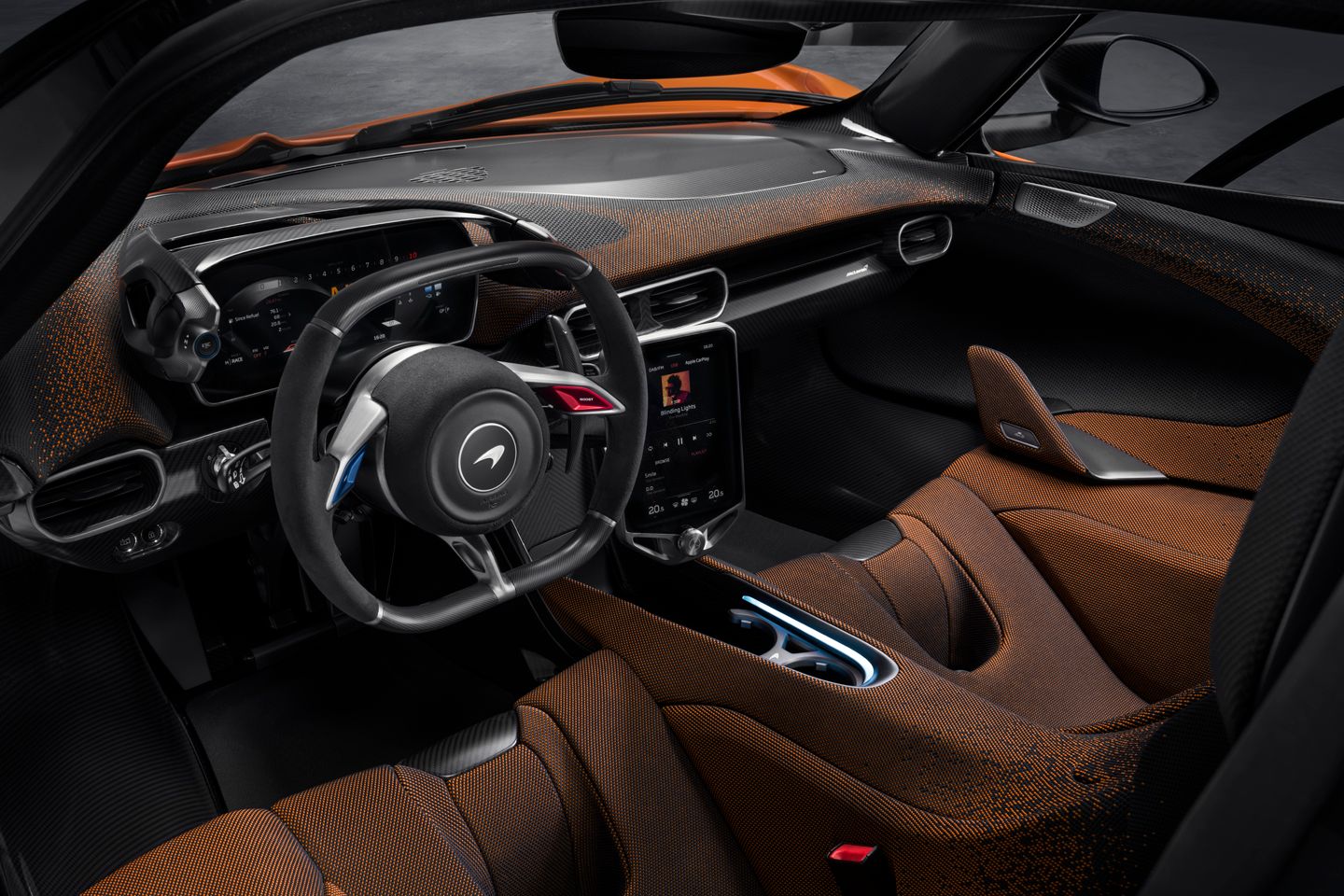
In Race mode, it very much lives up to this name, moving 300mm rearward (yes, very nearly a foot) and through a 180-degree arc to effectively become an extension of the underbody by sitting behind the trailing edge of the diffuser. PH won’t pretend to know how this works in detail (suffice it to say, McLaren had to get an F1 aerodynamicist to design the W1) but we can all appreciate the benefit of generating five times more downforce versus the road configuration – as much as 1,000kg at 174mph, in fact – while producing 20 per cent less drag than a McLaren Senna when in DRS mode.
Accordingly, if there is a USP ace card up the W1’s sleeve, it is the ‘road to track’ character transformation that occurs when you select Race mode. The car needs six individual E-motors to lever the front and rear wings into their most aggressive position, while the all-new McLaren Race Active Chassis Control III system – which gets pushrods for the first time, alongside active heave dampers and titanium torsion bars inspired by F1 – drops the ride height by 37mm at the front and 17mm at the rear, simultaneously applying much stiffer settings to get the best from standard-fit Pirelli P Zero Trofeo RS tyres.
All of this effort is intended to provide not only the ‘stable aerodynamic platform’ you need when outgunning a Senna at Nardo, but also to mitigate the requirement for an additional driven axle. Discussion of this cropped up again in light of the W1’s prodigious output, but McLaren reckons the car manages load and grip so effectively that all-wheel drive would be redundant, and that its ‘extraordinary Formula 1 know-how’ has helped create a RWD supercar that can comfortably live with the dynamic strain of 911hp per tonne (the highest power-to-weight ratio the manufacturer has claimed so far for one of its supercars).


The bulk of that power comes from the clean-sheet (McLaren is adamant about that) flat-plane crank, 90-degree MHP-8 engine, which it has spent at least the past four years undergoing in-house development. This produces 928hp and 664lb ft of torque on its own – and, at 233hp per litre, is the most power-dense engine the firm has ever made. Naturally it was built with one eye on the scales: lightweight aluminium features in the block, cylinder head and pistons – and is said to be marginally lighter than the old M840T, while being 55mm shorter. Again, because space is at a premium – especially in a car which must also accommodate 10 heat exchangers to ensure problem-free high performance when on track.
That the new V8 outputs 103hp more than the McLaren Senna GTR obviously speaks to the level of performance being harnessed, although it’s likely its ability to access 30 per cent more peak twist from as low as 2,500rpm (thanks to charge-cooled, twin-scroll turbochargers) and rev to 9,200rpm that will be the defining features of the latest unit. The previous V8 was hardly lacking in torque or keenness to rev, but McLaren is well aware of how its flagship engine often struggled in subjective comparisons against direct rivals – its replacement, which gets tubular manifolds in the exhaust along with equal-length runners, promises a ‘crescendo’ quite unlike anything the manufacturer has previously brought to market. We can hardly wait for that.
Nevertheless, like the P1, you will also be able to drive the W1 in complete silence for short distances, should you wish. Although with the battery capacity limited to 1.384kWh, you’ll be lucky to get more than one-and-a-half miles down the road. The W1’s E-module, which weighs just 20kg, is grafted to the side of the all-new eight-speed DCT, and is capable of contributing up to 347hp and 324lb ft of torque to proceedings – but generally speaking, this is meant to occur in conjunction with the V8. The car defaults to Comfort mode, where the F1-derived radial flux E—Motor is used for torque infill at low revs only. In Sport you get full hybrid power (‘adding theatre to gear shifts’, McLaren says) although once in Race mode you get an additional choice between GP, which aims for ‘consistency over a longer track session’ or Sprint, which, as it suggests, offers maximum performance over one lap (of the one-way system).
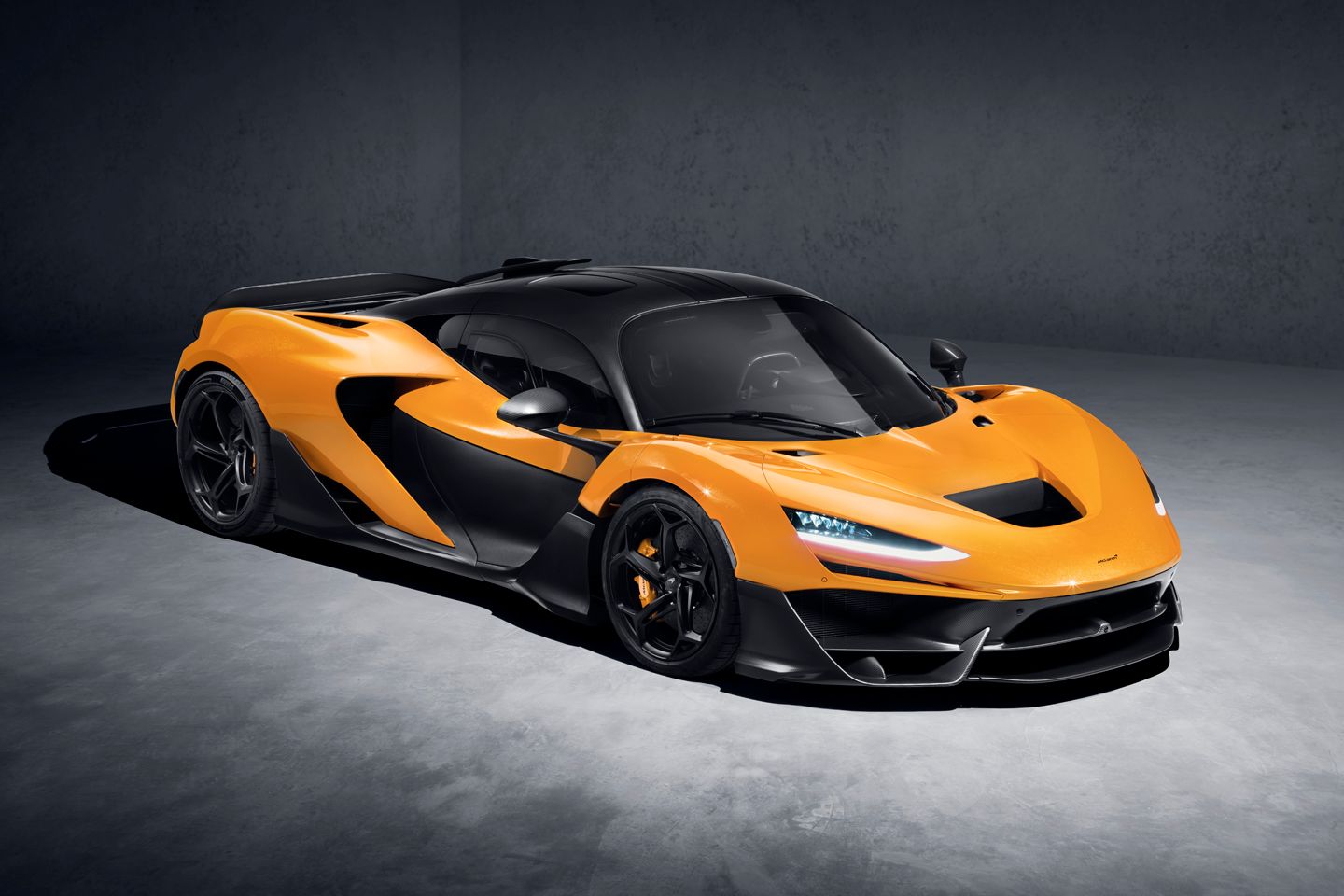
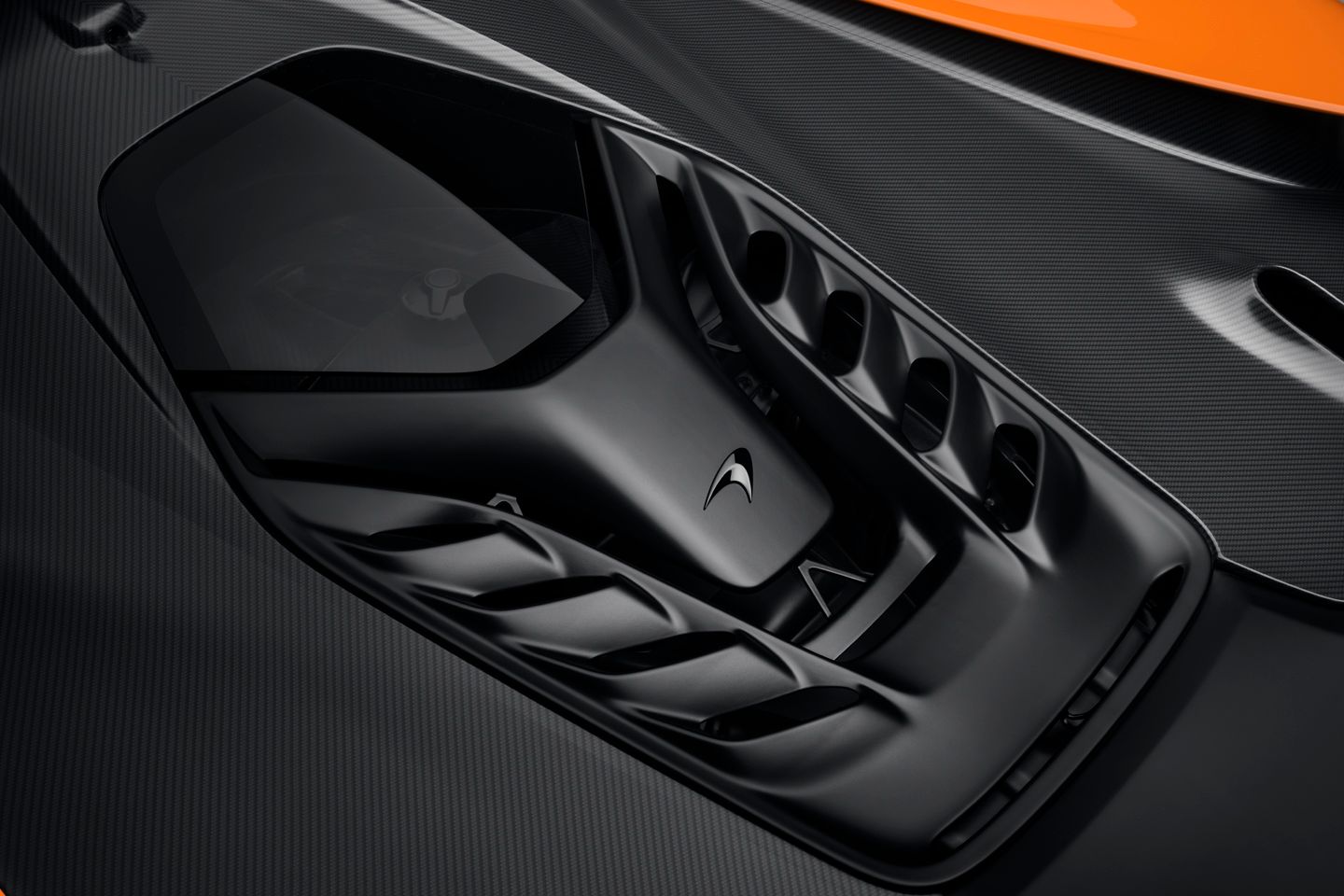
Beyond this choice, there are also two thumb-reachable buttons on the steering wheel, one inevitably marked ‘Boost’, the other ‘Aero’. The first gives you the full E-module beans for overtaking (for precisely how long is not specified); the second activates the Active Long Tail’s Drag Reduction System (because race car). So while McLaren says you can plug the battery in if you wish – it apparently takes around 20 minutes to charge to 80 per cent via an EVSE cable – the W1’s status as a plug-in hybrid is fairly tenuous. It’ll never not have enough power to crank the engine or provide sufficient drive for you to reverse (there is no conventional gear ratio for backing up). A decade-old, fully-charged P1 would actually get you further up the road in EV mode; McLaren’s measure of the W1’s superiority is in delivering nearly twice the power for a fraction of the weight penalty. That it has managed to keep the car to a 1,399kg dry weight has much to do with this difference.
Its contribution is fed into the transmission downstream of the clutches, which means the combined peak torque is delivered at the input shaft, before being transmitted to the road via a new hydraulic E-differential. McLaren had didn’t dwell on this component at the W1’s presentation (there is still much fine-tuning to be done with the car a year from production) though it promises ‘heightened driver involvement’ from the arrangement. It is for that same reason that McLaren has again opted to stick with hydraulic steering, which required a cut-out on each side of the monocoque to mount the rack given the absence of a subframe. McLaren reckons that by positioning it closer to the centre of the wheels, it maintains optimal geometry no matter which of the car’s ride heights is selected.
Braking, as you might imagine, is likely to be no less epic in the W1 than gaining speed in the first place. According to its maker, the car will stop from 124mph in 100 metres and from 62mph in just 29 metres, thanks to the McLaren Carbon Ceramic Racing+ (or MCCR+) system. These add an extra ceramic layer to the discs for improved durability, and feature 6-piston monobloc calipers at the front with a 4-piston version at the back, both gripping 390mm discs. Just as the position of the front and rear wing constantly adjust while driving in Race mode, so they respond under braking; the Active Long Tail functioning as an airbrake while the front wing swings up to reduce pitch sensitivity.
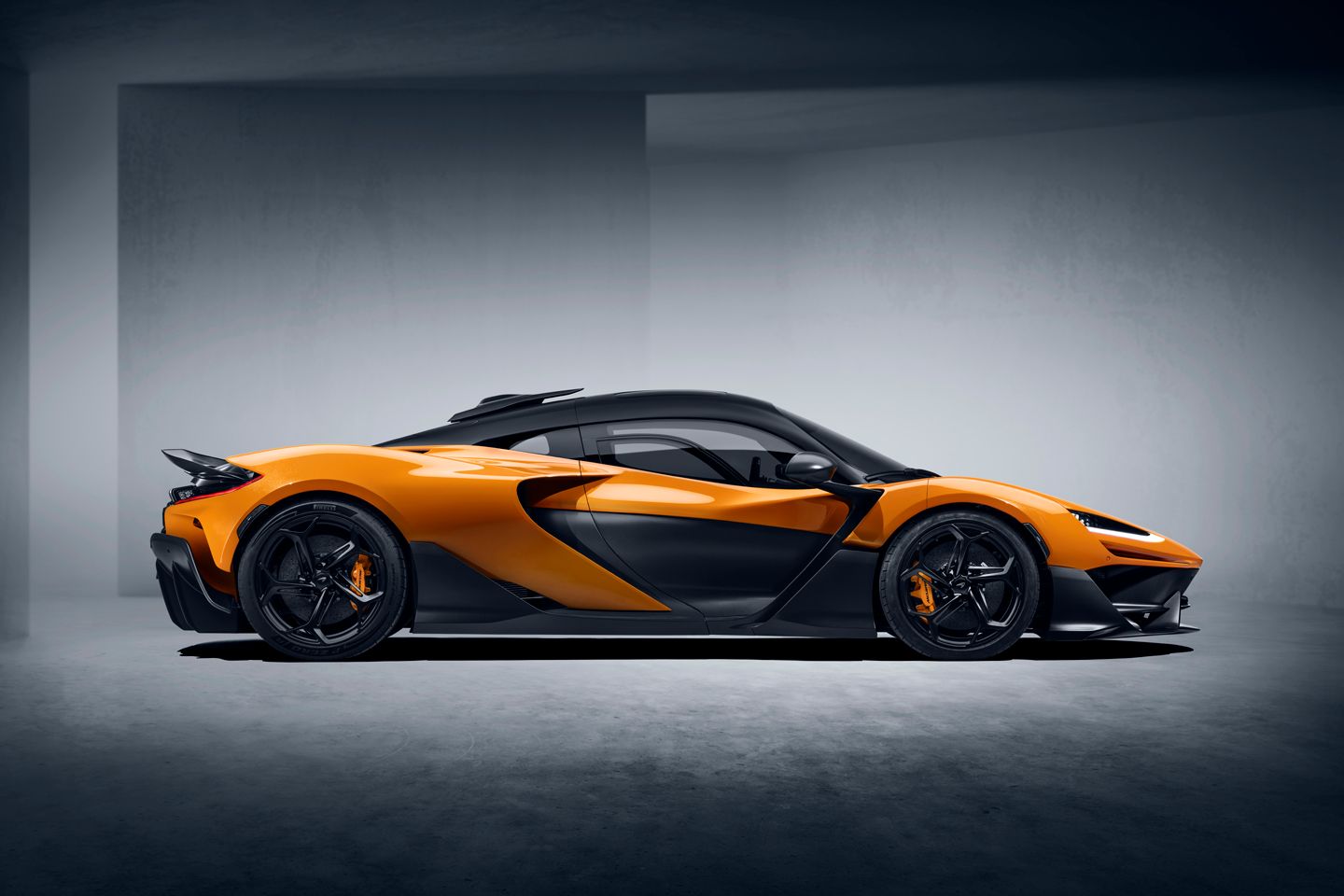
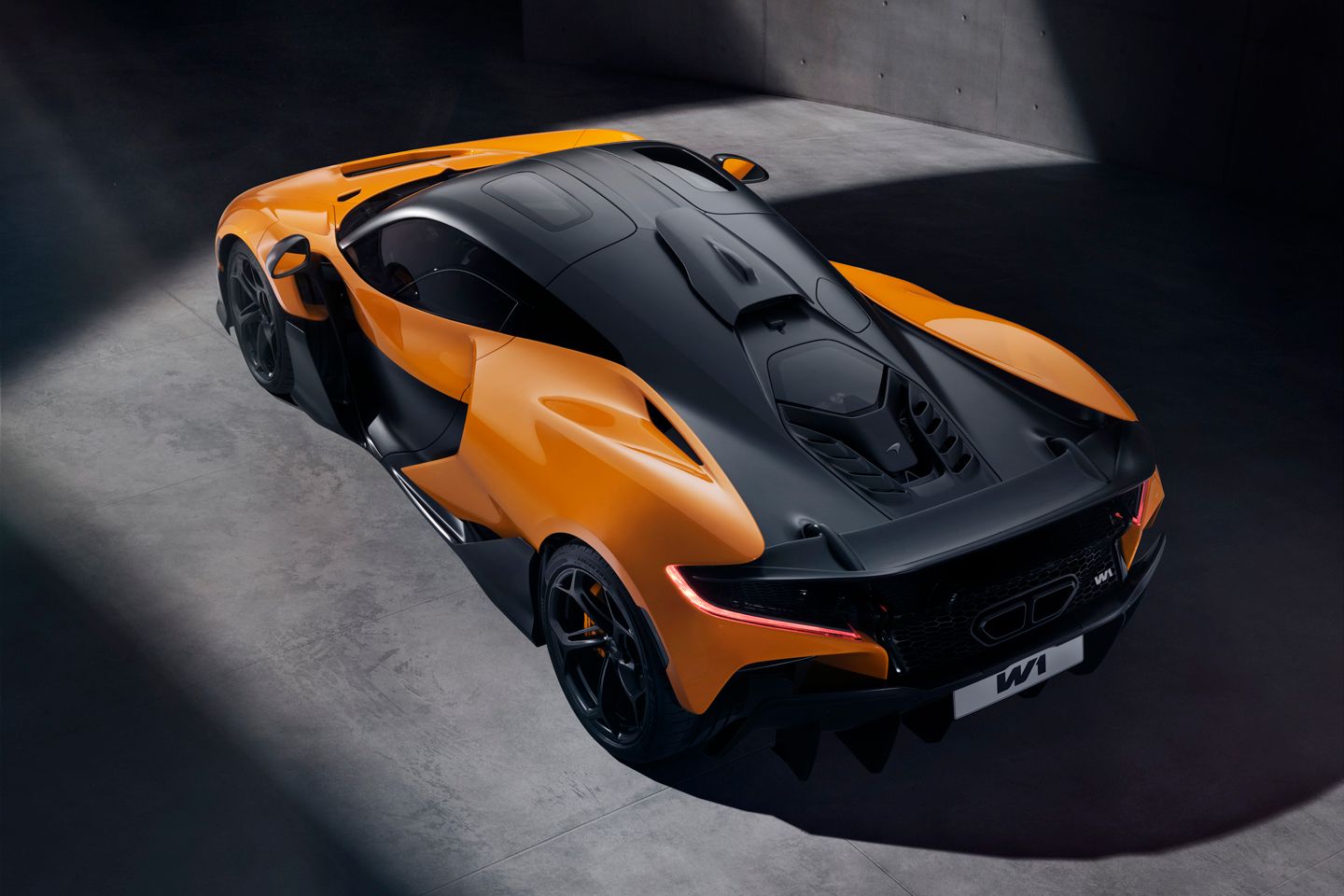
Talking of swinging up, let’s finish on those doors. After three decades, McLaren has stepped away from the traditional dihedral design, preferring the aerodynamic advantages of what it calls anhedral doors (although as they hinge from the top, it might be easier to simply say gull-wing). The new shape and repositioned A-pillar helps with engine cooling, but also aids getting in and out, particularly when getting your feet into the higher footwell. Despite the race-style driving position and floor-mounted adjustable pedals, McLaren reckons the cabin is ‘remarkably spacious’ and affords occupants and an ‘exceptional’ view out – not least because those A-pillars are the slimmest yet. Certainly its basic dash layout is reminiscent of the Artura, although the steering wheel, flattened top and bottom and with integral shift lights, is new to the W1, as is the use of something called InnoKnit, an ‘infinitely flexible and super-lightweight material’ that can be tailored to any surface.
Be that as it may, the presence of a new storage area between the seats – equipped, incredibly, with a sliding cupholder – is a reminder that McLaren only wants to take its race ethos so far; the W1 is not a stripped-out, take-no-prisoners track machine. The whole point is that while it has that club in its bag, its presence isn’t meant to foil the W1’s usability or lasting appeal as a road car. Unlike something as rarefied as the Speedtail, McLaren wanted to build an Ultimate Series model that customers could actually drive. Quite how much they end up doing that, when no version of the W1 will leave Woking for less than £2m, remains to be seen. Regardless, the case it made to its global fanbase apparently resonated: without seeing the car or knowing its name, all 399 examples were allocated ahead of the press reveal. The model’s lineage and limited edition status probably made this outcome a foregone conclusion. Whether or not the W1 actually lives up to the hallowed status of its predecessors remains to be seen. But McLaren, once again, appears to have gone all-in.

